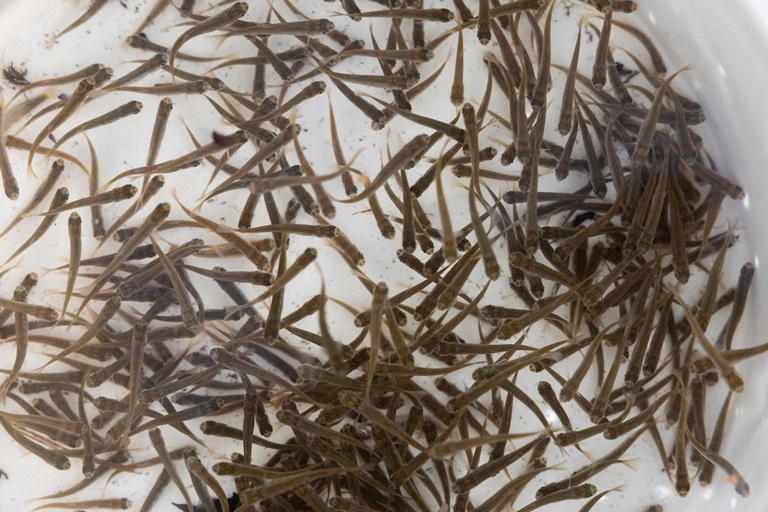Using Innovative Approach, DWR Studies Feasibility of Returning Chinook Salmon to Historic Habitat Along the Feather River
Juvenile salmonids are collected from the screw traps placed on the Feather River. This is part of a Department of Water Resources project to study the potential of returning spring-run Chinook salmon to historically available cold-water habitat in the Feather River Watershed above Lake Almanor. Photo taken March 8, 2024.
Along the North Fork of the Feather River, the Department of Water Resources (DWR) is conducting an innovative reintroduction feasibility study for Central Valley spring-run Chinook salmon that would help boost the salmon population and potentially return the species to its historic habitat.
Historically, spring-run Chinook salmon would have access to spawning and rearing habitat areas located above Lake Almanor. However, numerous dams that were built since the 1920s have cut off Central Valley salmon from accessing that habitat. This, in addition to other factors such as climate change, has contributed to a decline in the salmon population over the past 100 years.
The study tests two methods of salmon egg placement; an egg box method, which is normally used for reintroduction programs, and direct injection into the gravel, which closely mimics what happens in nature. The two methods of egg placement are used so scientists can compare how each method performed in that environment and have more control over how those eggs emerge.
To make this study happen, DWR scientists started by collecting eggs back in October 2023 at the Feather River Fish Hatchery in Oroville. They took a select group of eggs and incubated them separately from the other production eggs at the hatchery. This was done so scientists could use genetics to determine which fish were part of the study if the fish are later found in nature. The separation also allowed scientists to sterilize the eggs, since these fish are only meant for the study and scientists don’t want to impact the existing ecosystem. After that incubation period, those eggs were brought to the study location and placed either into one of the egg boxes or injected into the river gravel directly.
Each method has its benefits. The egg box method allows scientists a lot of control over checking on those eggs throughout the incubation period. The egg boxes also provide protection for the eggs. Meanwhile, the egg injection method involves injecting the eggs in a native material of gravel, also referred to as an artificial redd. “Redds” are the nests where female salmon lay their eggs. However, the gravel injection method posed some challenges for monitoring this past year. To address these challenges, right before the eggs hatched and then emerged from the gravel, DWR scientists placed emergence traps over those artificial redds so they could determine how many fish survived in that environment.
The whole process, from placement of the eggs to hatching and emerging from the gravel, took place from November 2023 through March 2024. This past winter, the scientists returned to the sites on a regular basis to check on the eggs and their progress.
This study is ongoing, as the eggs used for both placement methods have since hatched this spring, and DWR scientists and partners plan to survey the river over the summer to see if some juveniles are growing and maturing in the North Fork Feather River and Warner Creek.
In addition to testing egg placement methods, the study also looks at how juvenile salmon are collected (trapped) once eggs have hatched and physically transported downstream below all major dams in the watershed.
Thanks to the Chester Diversion Dam, an artificial structure that was built in the 1970s, scientists are better able to trap juveniles at a very high rate. The traps at the Chester Diversion Dam are used most of the year when river flows are stable. There are also traps one-quarter mile downstream of the Diversion Dam, which are used to catch migrating juveniles when flows are high, primarily during peak snowmelt.
Trap performance and function will continue to be tested throughout the study, since trapping the juveniles as they migrate downstream and relocating them into the lower Feather River below Lake Oroville would be a key component if a long-term reintroduction program is approved in the future.
Because this is a study, not a reintroduction program, all juveniles trapped in the North Fork Feather River are released on-site in the North Fork Feather River (back into those same waters) so they can continue into Lake Almanor. In Lake Almanor, the juveniles can either grow or go on to become prey for large trout that live in the lake as part of the natural life cycle.
Over the next year, scientists will incorporate lessons learned from the first year of this study while repeating certain elements. DWR’s goal is to improve the egg injection process and be even more effective at capturing juveniles. This will provide valuable insights for potential future actions that may benefit the recovery of salmon in the watershed. Additional studies will also evaluate the habitat to ensure the conditions are suitable for all life-stages of salmon to thrive in this environment. Overall, this is a two-year study funded by the DWR Riverine Stewardship Program, which helps DWR's Feather River Section oversee the work in coordination with the local community, area Tribes, and other agencies. The ultimate goal is to determine the feasibility of a long-term, successful reintroduction program.
Visit our Pixel account to see photos of the study and egg deployment methods. Watch a video about the study on our YouTube channel. Learn more about how DWR and partners are supporting California’s salmon population by visiting this StoryMap.